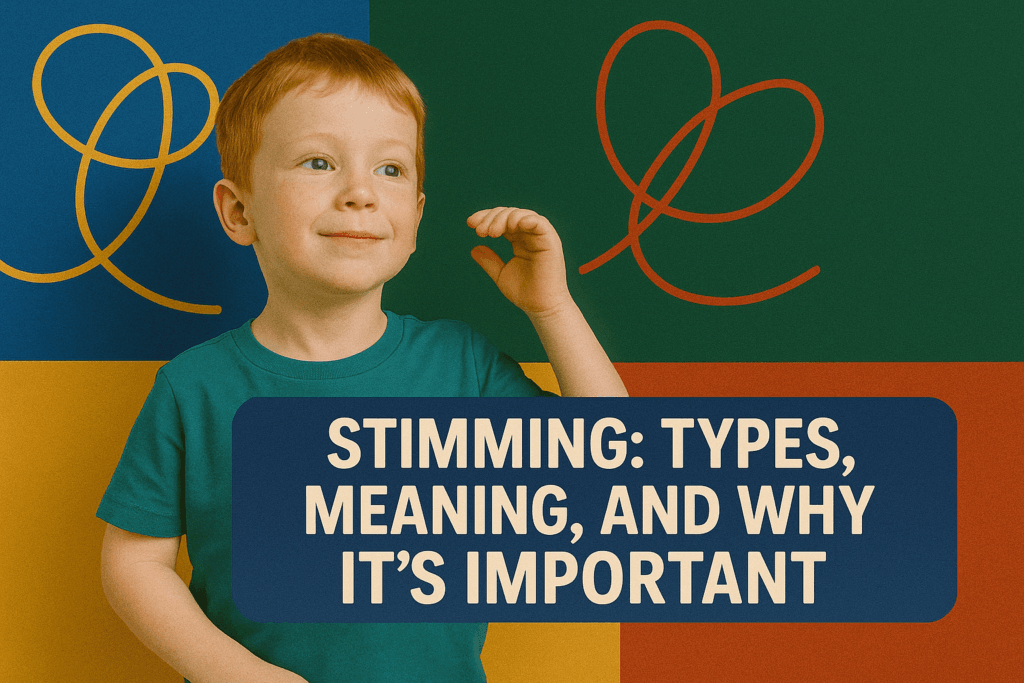Understanding the world through motion, rhythm, and comfort…
🧠 What is Stimming?
“Stimming” is short for self-stimulatory behavior. It refers to repetitive movements, sounds, or actions that help individuals regulate emotions, process sensory input, or simply bring joy. It’s particularly common among autistic individuals, but everyone engages in some form of stimming. For example:
- Tapping a pen 🖊️
- Bouncing your leg 🦵
- Humming when nervous 🎵
For people on the autism spectrum, stimming serves a deeper neurological and emotional function.
🧩 Why Do People Stim?
Autistic individuals often stim to:
- Self-soothe during stressful situations 😰
- Process overwhelming sensory input 🎧🔦👃
- Express excitement or happiness 😄
- Regain control when they feel anxious or out of place 🌀
In many cases, stimming is a vital coping strategy.
🔍 Stimming: Types, Meaning, and Why It’s Important
Let’s break down Stimming: Types, Meaning, and Why It’s Important into key areas:
🤲 Types of Stimming
- Visual Stimming
- Flicking fingers in front of eyes 👋
- Watching spinning objects 🔄
- Light reflections and patterns ✨
- Auditory Stimming
- Humming or repeating words 🎶
- Making clicking sounds 👂
- Listening to the same song over and over 🎧
- Tactile Stimming
- Rubbing hands together 🤝
- Touching specific textures 🧵
- Scratching or tapping surfaces 👆
- Vestibular Stimming (Movement)
- Rocking back and forth ⬅️➡️
- Spinning or twirling 🌀
- Jumping repeatedly 🦘
- Olfactory & Taste Stimming
- Smelling objects 👃
- Licking or chewing non-food items 🍬
🧩 Meaning Behind the Behavior
- Comfort & Predictability: In a world that often feels chaotic, stimming brings structure.
- Emotional Regulation: Helps individuals manage both joy and distress.
- Non-verbal Communication: Sometimes, stimming expresses what words cannot.
🌈 Why It’s Important
Understanding Stimming: Types, Meaning, and Why It’s Important is crucial because:
- It encourages acceptance instead of suppression 🙌
- It fosters inclusivity in schools, workplaces, and public spaces 🏫🏢🌍
- It prevents harm caused by misunderstanding or punishment 🚫❌
👶 Is Stimming Always Autism-Related?
No! While prevalent in autism, stimming is a human behavior. But in autism, it’s more frequent, intense, and functionally important.
⚠️ When is Stimming a Concern?
Stimming should generally be accepted. However, it may require intervention when:
- It’s harmful (e.g., head-banging) ❌
- It disrupts learning or daily functioning ⚠️
- It causes social isolation or bullying 😞
In these cases, therapies like Occupational Therapy (OT) or Behavioral Interventions can help offer safer alternatives.
🛠️ Supporting Healthy Stimming
Here’s how to support someone who stims:
✅ Don’t shame or punish
✅ Create a sensory-friendly environment
✅ Provide fidget tools
✅ Allow breaks during overwhelming tasks
🎗️ Breaking the Stigma Around Stimming
Autistic individuals often face stigma for stimming in public. It’s time we:
- Normalize stimming 💙
- Educate the public 🧠
- Celebrate neurodiversity 🌈
❤️ Support Autism Wings Inc.
At Autism Wings Inc., we believe in creating holistic support systems for children with autism—including nutritional education, therapy, and soon, a dedicated school!
We’re currently raising funds to build a specialized Autism School that nurtures every aspect of development. Your contribution can change lives.
🌐 Visit us: www.autismwings.com

